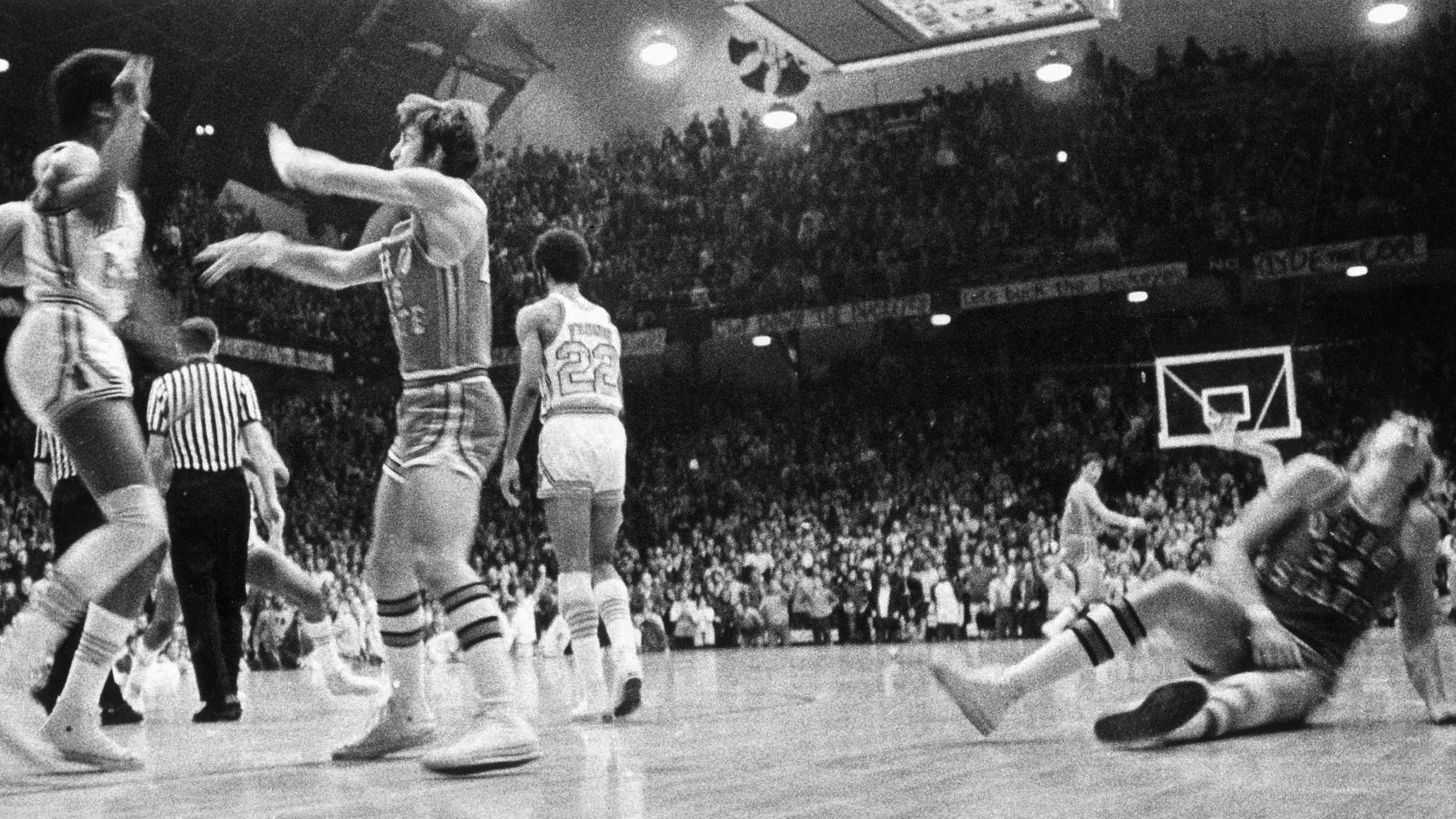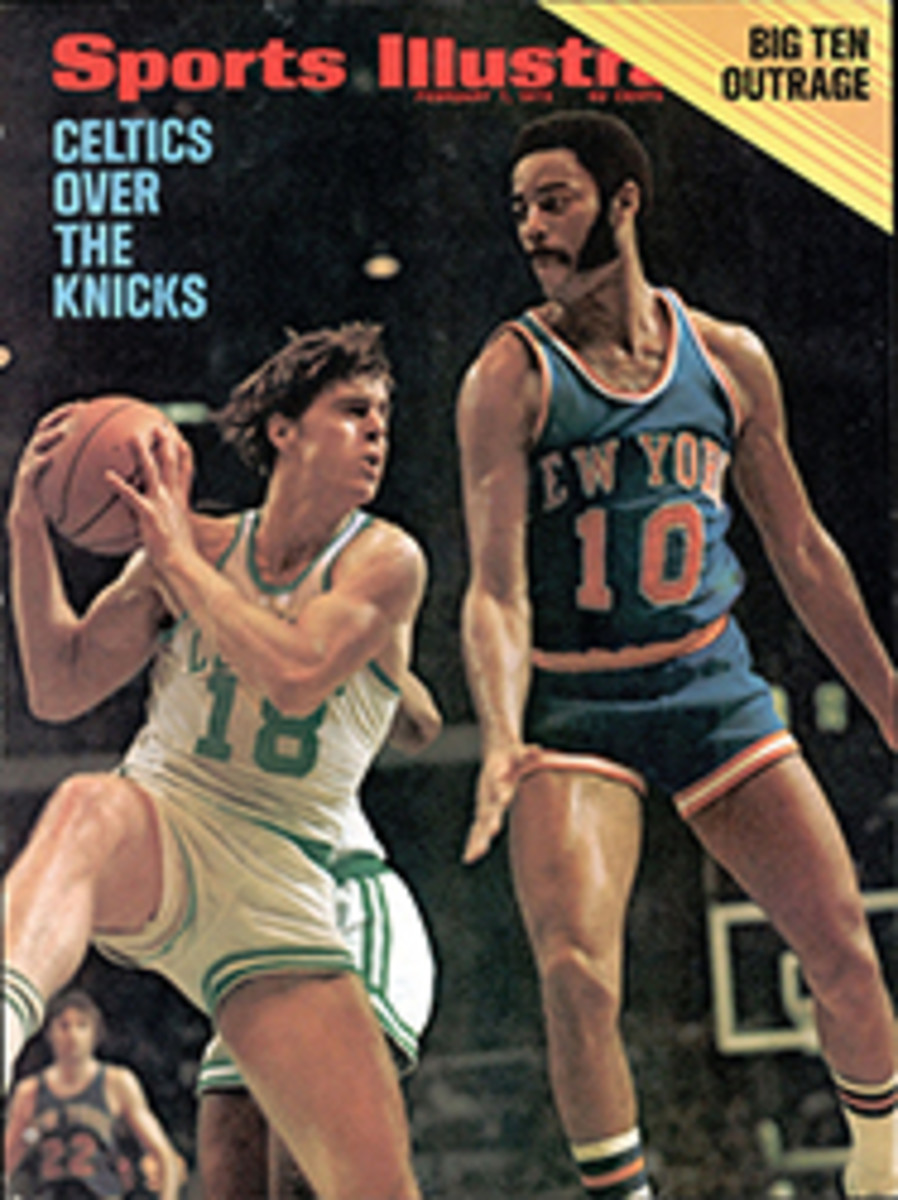I remember getting my copy of SI in the mailbox and reading this. I highlighted some of the most ridiculous, and racist, comments below.
AN UGLY AFFAIR IN MINNEAPOLIS
WHEN AN OVERPSYCHED MINNESOTA BASKETBALL TEAM WENT BERSERK IN A CRITICAL BIG TEN GAME, LUKE WITTE AND HIS OHIO STATE TEAMMATES WERE NOT THE ONLY VICTIMS; THE ENTIRE SPORT EMERGED WITH A BLACK EYE
He had been wheeled out of Minnesota's Williams Arena on a long stretcher, bleeding and numb. At the university hospital he had spent an hour in the emergency room, where they patched him up as well as possible, then admitted him for the night. Now, on the day after the riot, only hours after he had become the victim of what the governor of Ohio called a "
public mugging," Luke Witte was a mess. His right eye was completely covered with a white patch. His left ear was swollen and colored purple. An angry red scab was on his left cheek. His lower lip was swollen and a large, flesh-colored Band-Aid covered the stitched-up gash on his chin. When he got on the plane that was to take him away from Minneapolis, a stewardess looked at him, smiled a stewardess' smile and asked, "Oh, did something happen to you?"
"Yeah," said Witte, managing an answering smile from under his bandages, scabs and stitches. "I had an accident."
Accident, indeed. What happened to Witte last week and others on Ohio State's basketball team can only be described as assault and battery. The attackers were the players and fans of the University of Minnesota, an emotional lot who apparently would not stomach the idea of losing to the Buckeyes in their Big Ten showdown. So, with 36 seconds left and Ohio State holding a 50-44 lead, they rioted. For a scary, improbable interval of one minute and 35 seconds, they came swinging and kicking at the Buckeyes from all sides of the floor.
Witte, Ohio State's talented seven-foot blond center, took his most serious blows when he was on the floor, writhing in pain and completely defenseless. It was an ugly, cowardly display of violence, and, when it was over, when the police and officials had finally restored order, the fans had the audacity to boo Witte as he was helped, bleeding and semiconscious, from the floor.
The final 36 seconds were not played, for fear that the Gophers and their fans would rage out of control. Later, when Paul Giel, Minnesota's new athletic director, visited the Ohio State locker room, he found Fred Taylor, the Buckeyes' coach, pale and quivering with rage and indignation.
"I knew it would be emotional," said Giel, apologetically, "but I had no idea it would be like this."
"It was bush," answered Taylor. "I've never seen anything like it. But what do you expect from a bush outfit?"
Specifically, Taylor was referring to young Bill Musselman, Minnesota's new coach, and the basketball program he brought with him from—of all places—Ohio. At Ashland College (SI, Dec. 15, 1969), Musselman built a reputation for showmanship, stingy defense and winning records. It was a reputation that was not always admired by a professor of philosophy who followed his teams there, Dr. Wayne W. Witte, father of Luke. Asked to comment on the brawl, the elder Witte said, "I'm not surprised. Musselman's intent seems to be to win at any cost. His players are
brutalized and animalized to achieve that goal."
Musselman inherited a sagging program at Minnesota this season. The Gophers had not won a Big Ten title outright since 1919 (they shared one in 1937) and student interest was low. He was the fifth Minnesota coach in five years. Nevertheless, when the selection committee asked him how long it would take to turn Minnesota into a winner, Musselman said, "We'll win right off. I don't believe in rebuilding years."
He does believe in big, strong teams. Soon after he arrived in Minneapolis, Musselman picked up two junior college transfers—Ron Behagen (6'9") and Bob Nix (6'3"). Together with another JC transfer, Clyde Turner (6'8") and Jim Brewer (6'8"), Corky Taylor (6'9") and Keith Young (6'5"), already at Minnesota, they instantly comprised the most intimidating team in the conference. All except Nix were blacks who had learned the game on city playgrounds. The only question was how they would get along with Musselman, known always as a strict disciplinarian. "Discipline is the most important thing in life," says Musselman.
Next to winning, of Course. To help achieve what Musselman considered a winning environment, inspirational slogans were painted by an assistant coach on the walls of Minnesota's locker room in maroon and gold. Over the door to the players' shower is this message, the pith of the Musselman philosophy: "Defeat is worse than death because you have to live with defeat."
The fans loved the team, they loved Musselman and they especially loved the Gophers' fancy pregame Globetrotters' warmup routines. By January, when the Big Ten part of the schedule opened, the team was ready. Minnesota knocked off four straight foes, while Ohio State had three conference wins heading into last week's showdown.
The tension and emotion began to build early. When the Buckeyes came on the floor, they were booed. Then came the Gophers with their Barnum & Bailey act. While their ball handling, passing and dribbling tricks—
all done to the loud, steady beat of heavy rock music played over the P.A. system—are entertaining, they also are designed to hype up the team and the crowd. Musselman says, "It motivates my players."
In retrospect, that seems an understatement. By the end of the warmups, and long before the start of the game, the Gophers and the 17,775 fans were motivated to the point of frenzy. Later, after Musselman's "disciplined" team had come unglued, Ohio State Athletic Director J. Edward Weaver pointed to the
warmups as the underlying cause of the riot.
As a whole, the game was rough and nerve-racking, but also cleanly played and well-officiated. The only incident of any sort before the slaughter came when the teams were going to their dressing rooms at halftime. As Nix passed in front of Witte, his left arm raised in a clenched-fist salute, the Buckeye center tried to shove the fist out of his way with an elbow and in the attempt clipped Nix lightly on the jaw. Later, Musselman claimed that was the incident that incited his players. "Our kids were really upset at halftime," he said.
With 11:41 remaining in the final period, Minnesota took a 32-30 lead on a jump shot by Taylor, replacing Behagen who had fouled out two minutes earlier. But then Ohio State scored 10 straight points to go in front 40-32. Try as they might, the Gophers could never get any closer than five points. As defeat became more and more apparent, the crowd began to turn ugly. At one point, the officials stopped the game because of various debris—peanut sacks, peanuts, pennies, Coke cups—that was splattering the floor. When it was announced that any more throwing would result in a technical foul against Minnesota, there were boos—and more debris. Still, the players seemed under control.
Then it happened. With the Buckeyes ahead 50-44, Witte was driving in for what promised to be an easy layup. Instead, Minnesota's Turner cut in front of Witte and clobbered him. Almost instantaneously Taylor got Witte with a sweeping overhand right hook on the ear. The crowd cheered, then booed when it was Turner who was called for a flagrant foul and ejected from the game. As Witte rolled over and slowly got up on all fours, Taylor walked up and extended his right hand in what seemed to be a gentlemanly gesture. But when Witte was almost to his feet, Taylor abruptly pulled him forward and drove his right knee into Witte's groin. The big center crashed back to the floor. Then the arena erupted in a swirl of flying fists. Later Taylor claimed, through Musselman, that Witte triggered the incident by spitting at him. But an inspection of slow-motion films does not reveal the spitting.
"I wouldn't have done it in the first place," said Witte. "And even if I wanted to, I couldn't have because I was down too low."
When Ohio State Guard Dave Merchant moved in on a retreating Taylor, Jim Brewer hit Merchant with a combination of punches and then, along with Turner, chased him down the sideline. Meanwhile, Behagen rushed from his seat on the bench to where Witte was lying helpless and viciously stomped the Ohio State player's neck and face.
Fred Taylor pulled off Behagen who, according to Taylor, screamed, "Let me go, man, let me go." Dave Winfield, who recently joined the Gopher varsity, joined the fray, too, dodging to mid-court where some Minnesota reserves and civilians were trying to wrestle Ohio State substitute Mark Wagar to the floor. Winfield leaped on top of Wagar when he was down and hit him five times with his right fist on the face and head. When the stunned Wagar managed to slip away, a fan pushed him to the floor and another caught him on the chin with a hard punch from the side.
As the riot increased in tempo, with fans now flooding the playing area, only one cop was anywhere to be seen. By the time others arrived and began pulling people apart, the damage was done. Witte and Wagar lay near each other, so dazed that neither could remember anything when questioned later. "I went blank after I was hit with the knee," said Witte. "The next thing I knew, I was in the emergency room at the hospital." Wagar got up and helped Witte off the court but does not recall doing it.
The next day, as everyone was trying to sort out the facts, Ohio State's Benny Allison, a black sophomore guard, introduced the theory that it had all been mainly a case of Minnesota blacks against Ohio State whites. Allison said: "It was a racial thing. You will remember that Wardell [Jackson] and I were right out there in the middle of it, just like everybody else, but nobody swung on us. They just passed us up and went for the other guys. Sometimes things like that happen."
It was left to Wayne Duke, commissioner of the Big Ten and a spectator at the game, to fix the blame. He stayed in Minneapolis to view films and talk with Musselman, Behagen and Taylor, among others, then two days later announced that Taylor and Behagen would be suspended for the rest of the season.
The penalty in a way was assessed by both Duke and Minnesota. Before his announcement, the commissioner received a 10 p.m. phone call from Giel informing him that the university had decided to suspend the two players indefinitely. The next morning the Minnesota Athletic Senate said the suspension would last at least until Feb. 15, but by that time Duke had determined on his stiffer penalty. He also cleared up a few points. The investigation, he said, turned up "no evidence" of racial overtones. As to the Buckeyes' part in the affair, he was satisfied that only in the Witte-Nix incident "were charges of excessive physical contact against Ohio State's players at all justified." He said, too, that "the game was under the control of the officials until the final 36 seconds." His interview with Corky Taylor, Duke said, "did not substantiate the charge of spitting"—Taylor amended earlier remarks to say that he thought Witte was going to spit at him—and Duke concluded that the riot was "precipitated" by Taylor's "unsportsmanlike act."
But Duke also left at least two questions hanging. To what extent did Musselman and his program contribute to an atmosphere conducive to violence? And why wasn't Winfield also suspended? Many people, particularly Ohioans, felt that the penalties imposed were not commensurate with the seriousness of acts that Duke himself termed "unprecedented" and "unacceptable in our society." In what was easily his most thought-provoking comment of the day, Duke said, "As you look back at it, isn't it terrible to say 'we were fortunate'?"
Fights always have been a deplorable part of college basketball, a game that thrives on emotion and contact. Lately, though, the brawls have developed in number and intensity to the point where thoughtful basketball people are concerned about the sport's direction. Millions saw the recent donnybrook between South Carolina and Marquette on TV. That was sobering enough, but Ohio State-Minnesota was different—and far worse. Instead of a fight erupting from blows struck in the heat of competition, this was a cold, brutal attack,
governed by the law of the jungle. It could be considered the inevitable result of the malaise that afflicts the sport these days, a stunning example of responsibility abdicated by a coach, the players he recruited and taught and the fans who followed them. Musselman made no attempt to stop the fight and showed no remorse afterward. As Fred Taylor said, "There's more at stake here than basketball games."
Taylor and his team moved on to Ann Arbor for a game with Michigan at the end of last week. Playing without Witte or Wagar, the Buckeyes were beaten by the Wolverines 88-78 for their first league loss in five games. (On the same day, Minnesota, minus Behagen and Taylor, to whom the Gophers dedicated the game, won 61-50 over Iowa and thus tied Michigan for the Big Ten lead with a 5-1 record.) Ohio State was called for 32 fouls to Michigan's 18 and afterward Taylor said, "What happened at Minnesota had an indirect effect on what happened here.... The officials were afraid that the crowd would come out of the stands again."
By week's end, Luke Witte's face was beginning to heal. "I still have some headaches," he said, "but I am feeling better all the time." He was lucky, maybe, but the sport he wants to play again was not looking so good.
He had been wheeled out of Minnesota's Williams Arena on a long stretcher, bleeding and numb. At the university hospital he had spent an hour in the emergency

vault.si.com



